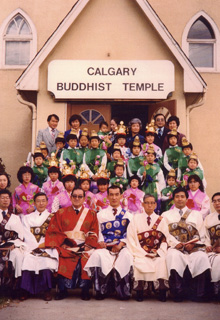Jodo Shinshu in Canada
Buddhism was likely first brought to Canada by Japanese immigrants in the late 1800’s. These immigrants, mostly farmers and fishermen, settled in British Columbia near Vancouver and Victoria — on farms in the Fraser Valley, and in fishing villages and lumber mill towns along the Pacific coast. A few settled in Alberta, near Lethbridge and Edmonton.
In 1904, a group of 14 Japanese Buddhists met in Vancouver with the objective of bringing a resident minister to Canada. The following year, the Honpa Honganji Temple, the mother temple of the Jodo Shinshu sect, sent Rev. Senju Sasaki. The congregation gathered for its first service on October 24, 1905.
The Nihon Bukkyo-kai (Japanese Buddhist Association) was formally incorporated in 1909 with 650 members. By 1941, eleven ministers were serving 16 temples in B.C.
During World War II, however, Jodo Shinshu suffered a major setback in Canada. Japanese-Canadians living near the Pacific coast were dispersed by the Canadian government to detention camps in the B.C. interior and to sugar beet farms in Alberta and Manitoba. In 1949, they regained their freedom with the lifting of the War Measures Act. Some returned to B.C. and others settled elsewhere.
In 1955, a National Conference in Toronto led to the formation of the Buddhist Churches of Canada
– in 2008, name changed to Jodo Shinshu Buddhist Temples of Canada (JSBTC). The Calgary Buddhist Temple is a proud member of this organization.
